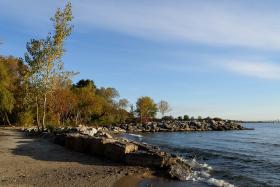By Veronica Volk
This story originally appeared on Great Lakes Today and is republished here with permission.
Officials in the United States and Canada have approved a plan to allow the level of Lake Ontario to fluctuate more — a change that has been opposed by some residents.

Lake Ontario shoreline. Image: Joe Desousa, Flickr
Lake Ontario’s water levels have been controlled by the Moses-Saunders Power Dam since the 1950s, but for decades, environmentalists have argued that the controls were damaging coastal wetlands.
In response to the concerns, officials with the International Joint Commission put forward Plan 2014, which allows for greater fluctuation between the lake’s highs and lows. Wetland scientists argue this variability is crucial in supporting the ecological diversity along the coasts.
“It is this process that maintains the diversity of wetland plant communities, and also the diversity of habitat for a whole variety of fish and wildlife species,” says Doug Wilcox of the College at Brockport.
The plan will also increase hydropower production and aid the shipping industry.
While the proposed regulations have been touted as a balanced plan, homeowners along the south shore of Lake Ontario have been vocal opponents. Residents along the lakefront say they fear greater fluctuation will partially destroy their property and reduce the value of their homes.
Dan Barletta owns lakefront land in Greece, New York. He says it’s not fair to change the regulations.
“People put money in based on the current regulation plans,” says Barletta. “That’s private property.”
Rep. John Katko also voiced his disproval of Plan 2014. He represents resident on Sodus Point, another community that fears fluctuation will damage their property.
“I am incredibly disappointed with today’s announcement that Plan 2014 will move forward,” Katko wrote in a statement. He says the plan “will have a devastating impact on the shoreline, homes, businesses, and vast agriculture economies of Wayne, Cayuga, and Oswego Counties.”
Proponents say no plan can completely eliminate the threat of erosion. And they argue that Plan 2014 could potentially build back natural barriers in some areas to protect against extreme weather.
Lana Pollack is the U.S. Chair of the International Joint Commission which put forward the plan. She says they hear the concerns of homeowners, but this plan is the best possible compromise.
“It’s hard to give 100 percent to any particular interest when there are competing interests involved,” says Pollack.
Plan 2014, which also affects the lower St. Lawrence, will go into effect next month.